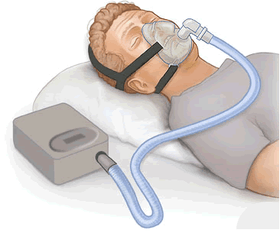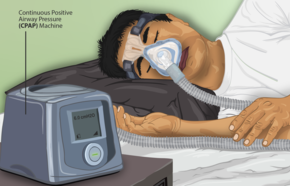Continuous positive airway pressure
Continuous positive airway pressure (CPAP) is a form of positive airway pressure (PAP) ventilation in which a constant level of pressure above atmospheric pressure is continuously applied to the upper airway. The application of positive pressure may be intended to prevent upper airway collapse, as occurs in obstructive sleep apnea, or to reduce the work of breathing in conditions such as acute decompensated heart failure.
| Continuous positive airway pressure | |
|---|---|
 CPAP therapy: flow generator, hose, full face mask |
History
Colin Sullivan (physician), an Australian physician and professor, is credited with having invented CPAP.[1]
Uses
CPAP typically is used for people who have breathing problems, such as sleep apnea. CPAP also may be used to treat pre-term infants whose lungs have not yet fully developed. For example, physicians may use CPAP in infants with respiratory distress syndrome. It is associated with a decrease in the incidence of bronchopulmonary dysplasia. In some preterm infants whose lungs have not fully developed, CPAP improves survival and decreases the need for steroid treatment for their lungs. In resource-limited settings where CPAP improves respiratory rate and survival in children with primary pulmonary disease, researchers have found that nurses can initiate and manage care with once or twice daily physician rounds.[2]
In March 2020 the USFDA suggested that CPAP devices may be used to support patients affected by Covid-19;[3] however, they recommended additional filtration as non-invasive ventilation may increase the risk of infectious transmission.[4]
Mechanism
CPAP therapy uses machines specifically designed to deliver a constant flow of pressure. Some CPAP machines have other features as well, such as heated humidifiers. CPAP is the most effective treatment for obstructive sleep apnea, in which the mild pressure from the CPAP prevents the airway from collapsing or becoming blocked.[5]
It is an alternative to positive end-expiratory pressure (PEEP). Both modalities stent the lungs' alveoli open and thus recruit more of the lung's surface area for ventilation, but, while PEEP refers to devices that impose positive pressure only at the end of the exhalation, CPAP devices apply continuous positive airway pressure throughout the breathing cycle. Thus, the ventilator itself does not cycle during CPAP, no additional pressure above the level of CPAP is provided, and patients must initiate all of their breaths.[6]
Delivery

Although delivery of CPAP through a nasal mask is the most common modality of treatment, other systems exist for interfacing with adults and children. Nasal CPAP is frequently used in infants, though its use is controversial. Studies have shown nasal CPAP reduces ventilator time but an increased occurrence of pneumothorax was also prevalent.[7] Oral masks and naso-oral masks are often used when nasal congestion or obstruction is an issue. Devices that combine nasal pressure with mandibular advancement devices (MAD) also exist.
Complications
Swallowing of air into the stomach may occur.
Settings and measurements
- CPAP
This is the pressure applied without pause or end to the airway. Generally using flow to generate the pressure. - PEEP
Positive end-expiratory pressure (PEEP) is the pressure in the lungs (alveolar pressure) above atmospheric pressure (the pressure outside of the body) that exists at the end of expiration. - Ramp
This feature is present on many devices and allows the user to reduce the pressure to lowest setting and gradually increase to the set pressure. This allows the user to fall asleep with the pressure at a more comfortable setting. - FiO2
Fractional O2 percentage – that is, the fraction of inspired oxygen that is added to the delivered air.
See also
- Positive end-expiratory pressure – Pressure above atmospheric in the lungs at the end of expiration
References
- https://www.sleepfoundation.org/articles/past-present-and-future-cpap
- Patrick, Wilson; Moresky, Rachel; Baiden, Frank; Brooks, Joshua; Morris, Marilyn; Giessler, Katie; Punguyire, Damien; Apio, Gavin; Agyeman-Ampromfi, Akua; Lopez-Pintado, Sara; Sylverken, Justice; Nyarko-Jectey, Kwadwo; Tagbor, Harry (June 2017). "Continuous positive airway pressure for children with undifferentiated respiratory distress in Ghana: an open-label, cluster, crossover trial". Lancet Global Health. 5 (6): e615–e623. doi:10.1016/S2214-109X(17)30145-6. PMID 28495265.
- "Ventilator Supply Mitigation Strategies: Letter to Health Care Providers". U.S. Food and Drug Administration. FDA. Retrieved 30 March 2020.
- "COVID-19 resources for anesthesiologists". asahq.org. American Society of Anesthesiologists (ASA). Retrieved 30 March 2020.
- Werman, Howard A.; Karren, K; Mistovich, Joseph (2014). "Continuous Positive Airway Pressure(CPAP)". In Werman A. Howard; Mistovich J; Karren K (eds.). Prehospital Emergency Care, 10e. Pearson Education, Inc. p. 242.
- Werman, Howard A.; Karren, K; Mistovich, Joseph (2014). "Continuous Positive Airway Pressure(CPAP)". In Werman A. Howard; Mistovich J; Karren K (eds.). Prehospital Emergency Care, 10e. Pearson Education, Inc.
- Morley, C. J.; Davis, P. G.; Doyle, L. W.; Brion, L. P.; Hascoet, J. M.; Carlin, J. B.; Coin Trial, I. (2008). "Nasal CPAP or Intubation at Birth for Very Preterm Infants" (PDF). New England Journal of Medicine. 358 (7): 700–708. doi:10.1056/NEJMoa072788. PMID 18272893.
External links
- Winters, Catherine (December 25, 2016). "How to Stop Snoring". Consumer Reports. Retrieved December 20, 2019.